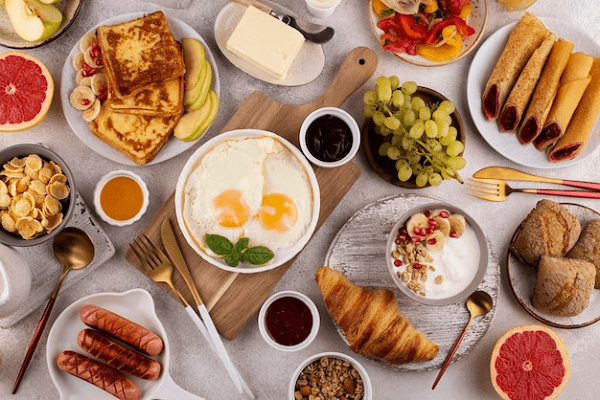Brunch- Brunch is a meal that combines elements of both breakfast and lunch, typically enjoyed during the late morning or early afternoon. It’s a popular social meal, often served on weekends or special occasions, where friends and family come together to enjoy a leisurely and indulgent meal. Brunch menus can vary widely, but they usually include a mix of breakfast and lunch dishes, such as eggs, bacon, sausage, pastries, sandwiches, salads, and even alcoholic beverages like mimosas or Bloody Marys.
Some common brunch items include:
- Eggs Benedict: Poached eggs served on English muffins with Canadian bacon and hollandaise sauce.
- Quiches: Savory pies filled with eggs, cheese, vegetables, and meats.
- Omelettes: Eggs cooked with a variety of fillings, such as cheese, vegetables, and meats.
- Pancakes and Waffles: Often topped with syrup, fruits, and whipped cream.
- French Toast: Slices of bread soaked in a mixture of eggs, milk, and spices, then fried or baked.
- Breakfast Burritos: Tortillas filled with eggs, cheese, and various toppings.
- Avocado Toast: Sliced avocado on toasted bread, often topped with poached eggs and various seasonings.
- Smoked Salmon: Served with bagels, cream cheese, and capers.
- Fruit Salad: A mixture of fresh fruits.
- Pastries: Croissants, muffins, and danishes.
Brunch allows for creativity and customization, so you can adapt the menu to your preferences or the occasion. It’s a relaxed and enjoyable way to start the day and can be served in restaurants, cafes, or at home with family and friends.
What is Brunch
Brunch is a meal that combines elements of both breakfast and lunch, typically enjoyed during the late morning or early afternoon. The term “brunch” is a portmanteau of “breakfast” and “lunch.” It’s a popular dining concept that allows people to enjoy a leisurely and satisfying meal that includes a variety of dishes from both the breakfast and lunch menus.
Brunch menus can vary widely, and they often include a mix of breakfast items like eggs, bacon, sausages, pancakes, and pastries, as well as lunch items such as sandwiches, salads, soups, and even more substantial dishes like pasta or grilled meats. In addition to traditional breakfast and lunch foods, brunch is also known for including beverages like mimosas (a combination of champagne and citrus juice) and Bloody Marys (a cocktail made with vodka and tomato juice), making it a more festive and indulgent dining experience.
Brunch is often associated with a relaxed and social atmosphere, making it a popular choice for weekend gatherings with family and friends. It can be enjoyed at restaurants, cafes, hotels, and even at home when hosting brunch parties. The specific dishes and foods served at brunch can vary by region and personal preference, allowing for a lot of creativity and customization.
Who is Required Brunch
“Brunch” is not the name of a person or an individual; it is a term used to describe a particular meal, as I explained in my previous responses. Brunch is a combination of “breakfast” and “lunch,” typically enjoyed during the late morning or early afternoon. It is not associated with a specific person or individual. If you have a different question or need information about a specific topic related to brunch or something else, please feel free to ask, and I’ll do my best to assist you.
When is Required Brunch

Brunch is a meal typically enjoyed during the late morning or early afternoon, usually falling between the hours of 10:00 AM and 2:00 PM. The exact timing of brunch can vary depending on personal preferences, cultural practices, and local customs. It is often considered a relaxed and leisurely meal, making it suitable for late mornings on weekends or special occasions.
However, the specific time for brunch can vary widely based on individual preferences and regional norms. Some people might have brunch earlier, around 10:00 AM, while others may have it closer to 2:00 PM. Brunch is not confined to a strict time frame, so it can be enjoyed whenever it is most convenient and enjoyable for you.
Where is Required Brunch
Brunch can be enjoyed in various locations, including:
- Restaurants and Cafes: Many restaurants and cafes offer brunch menus, and you can find them in cities and towns around the world. They often serve a variety of brunch dishes and beverages to cater to different tastes.
- Hotels: Some hotels host brunch events or offer brunch service on weekends, which may include buffet-style options with a wide range of breakfast and lunch items.
- Homes: Brunch can also be enjoyed at home when you prepare and serve brunch dishes for yourself, your family, or your friends.
- Outdoor Locations: Some people opt for brunch picnics or gatherings in parks, gardens, or outdoor spaces, especially in pleasant weather.
The location of brunch can vary based on personal preference and the occasion. It can be a casual and enjoyable meal that can be held in many different settings, from formal dining establishments to a cozy corner of your own kitchen.
How is Required Brunch
The experience of brunch can vary widely based on where and how it is enjoyed, but here are some common characteristics of how brunch is typically:
- Informal and Leisurely: Brunch is known for its relaxed and informal atmosphere. It’s a time to unwind and enjoy a meal without the rush associated with breakfast or the formality of dinner.
- Varied Menu: Brunch menus often feature a combination of breakfast and lunch items. This allows for a wide variety of choices, from traditional breakfast dishes like eggs and bacon to lunch items like sandwiches or salads.
- Beverages: Brunch often includes a selection of beverages. Popular brunch drinks include coffee, tea, fruit juices, mimosas (a cocktail made with champagne and citrus juice), Bloody Marys (a cocktail made with vodka and tomato juice), and other alcoholic or non-alcoholic options.
- Social Occasion: Brunch is commonly enjoyed with friends and family. It’s an opportunity to socialize, catch up, and spend quality time together. Some people also use brunch as a way to celebrate special occasions.
- Brunch Venues: Brunch can be enjoyed at restaurants, cafes, hotels, or even at home. Many dining establishments offer brunch on weekends, and you can also prepare a brunch spread in your own kitchen if you prefer.
- Timing: Brunch typically takes place late in the morning or early in the afternoon, often between 10:00 AM and 2:00 PM. This allows people to sleep in a bit and then enjoy a combined breakfast and lunch.
- Diverse Offerings: The dishes and items on a brunch menu can be diverse and cater to various dietary preferences and tastes. You can find classic breakfast items like pancakes and omelets, as well as more substantial lunch options like burgers or salads.
Overall, brunch is a versatile and enjoyable meal that brings together elements of both breakfast and lunch in a way that encourages relaxation and social interaction. It’s a time to savor good food and good company in a laid-back setting.
Case Study on Brunch
The Riverside Cafe’s Sunday Brunch
Background: The Riverside Cafe, a popular riverside restaurant in a mid-sized city, decided to launch a new Sunday Brunch event to attract more customers and provide an additional dining option. The cafe had been known for its lunch and dinner offerings but saw an opportunity to tap into the growing brunch market.
Objectives:
- To establish The Riverside Cafe as a destination for delicious and enjoyable brunch experiences.
- To increase customer footfall and revenue on Sunday mornings.
- To create a diverse and appealing brunch menu.
Key Steps and Considerations:
- Market Research: The restaurant management conducted market research to understand the local brunch scene, customer preferences, and competitive offerings. They identified that there was a demand for a diverse menu that catered to various dietary requirements and a relaxed, family-friendly atmosphere.
- Menu Planning: The Riverside Cafe’s chef created a menu that balanced traditional breakfast items (e.g., eggs, pancakes, and waffles) with more creative brunch options (e.g., avocado toast variations, quiches, and brunch cocktails). The menu included gluten-free and vegan choices to accommodate dietary restrictions.
- Staffing: Additional staff were hired to manage the increased customer volume during brunch hours. This included kitchen staff, servers, and bartenders for brunch cocktails.
- Promotion: The cafe heavily promoted the Sunday Brunch event through its website, social media channels, and local advertising. They used enticing images of brunch dishes and ran special promotions to attract diners.
- Reservations: To manage customer flow and prevent long waiting times, The Riverside Cafe implemented a reservation system. Customers could book tables in advance, ensuring a smoother and more organized brunch service.
- Service Timing: Brunch service was scheduled from 10:00 AM to 2:00 PM. The cafe offered two seating options to accommodate more customers.
- Atmosphere: The Riverside Cafe created a welcoming brunch atmosphere with cozy seating arrangements, live acoustic music, and a view of the river. They placed fresh flowers on each table to enhance the ambiance.
- Quality Control: The restaurant maintained strict quality control to ensure that each dish met their high standards. The head chef and kitchen staff received special training for the brunch menu.
- Customer Feedback: After launching the Sunday Brunch, The Riverside Cafe encouraged customers to provide feedback through comment cards and online reviews. This helped them make continuous improvements.
Results: The Riverside Cafe’s Sunday Brunch became a huge success. It attracted a diverse customer base, increased Sunday revenue, and established the cafe as a top brunch destination in the city. Positive word-of-mouth and online reviews further fueled its popularity.
Conclusion: This case study highlights the steps and considerations involved in successfully launching a brunch event at a restaurant. Proper planning, market research, menu diversity, effective promotion, and a welcoming atmosphere all contributed to the success of The Riverside Cafe’s Sunday Brunch.
White paper on Brunch
A white paper is typically a detailed and formal document that provides in-depth information, analysis, and recommendations on a specific topic. While it’s not common to create a traditional white paper on the subject of “brunch,” I can provide you with a brief white paper-style overview of brunch, its cultural significance, and its evolution as a dining concept.
Title: The Brunch Phenomenon: A Cultural Exploration
Abstract: This white paper explores the cultural significance of brunch, its historical origins, and its evolution into a popular dining concept. Brunch, a meal that combines elements of breakfast and lunch, has gained prominence as a social and culinary event. This document examines the reasons behind its popularity, its impact on society, and the key elements that contribute to a successful brunch experience.
1. Introduction: Brunch, a portmanteau of “breakfast” and “lunch,” is a unique dining concept that has captured the imagination of people around the world. This white paper delves into the history, cultural significance, and the evolving nature of brunch.
2. Historical Origins: Brunch’s roots can be traced back to various cultures and traditions. The concept of a leisurely mid-morning meal has been a part of human culinary history for centuries. In the 19th century, English brunches, hunting breakfasts, and Sunday church gatherings played pivotal roles in shaping modern brunch.
3. The Popularity of Brunch: Brunch has witnessed a surge in popularity over recent decades. Its appeal lies in its flexibility, bridging the gap between traditional meal times, and offering a diverse range of dishes, both savory and sweet. It has become a staple for weekend dining, with many restaurants and cafes offering brunch menus.
4. Cultural Significance: Brunch has emerged as a social event where friends and family come together to enjoy a relaxed and convivial atmosphere. It reflects changing societal norms, where people seek a break from their hectic lives and embrace a slower, more indulgent pace of living.
5. Key Elements of a Successful Brunch: a. Menu Diversity: A successful brunch menu combines breakfast and lunch items, catering to various tastes and dietary preferences. b. Timing: Brunch typically occurs during late morning or early afternoon, making it a perfect weekend indulgence. c. Beverages: Brunch often includes a selection of drinks, such as coffee, tea, and brunch cocktails like mimosas. d. Atmosphere: Creating a relaxed and inviting ambiance contributes to the overall experience. e. Social Interaction: Brunch is a social occasion, fostering connections and gatherings among people.
6. Conclusion: Brunch represents more than just a meal; it is a cultural phenomenon that reflects changes in society’s values and lifestyles. It has become a beloved tradition that brings people together, offering a leisurely break from the daily grind. Understanding the cultural significance of brunch can enhance our appreciation of this unique dining experience.
7. References: This section lists the sources and references used in the white paper.
Please note that this white paper is a simplified overview of brunch and doesn’t include extensive research or analysis. Traditional white papers are typically longer and more research-oriented. If you plan to create a comprehensive white paper on brunch or any specific aspect of it, you may need to conduct in-depth research and provide more detailed analysis and recommendations.
Industrial Application of Brunch
Brunch is traditionally associated with the food service and hospitality industry rather than industrial applications. It is a meal concept that combines elements of breakfast and lunch, providing a relaxed and enjoyable dining experience. While brunch itself isn’t directly used in industrial applications, the food industry and related sectors can indirectly benefit from its popularity. Here’s how:
- Food Production and Distribution: The food production industry can benefit from the demand for brunch-related products, such as pastries, bread, eggs, and various brunch ingredients. Manufacturers and distributors may see increased sales for items commonly consumed during brunch hours.
- Hospitality and Catering: The hospitality industry, including hotels, restaurants, and cafes, plays a significant role in providing brunch services. These establishments may offer brunch menus, host brunch events, and provide catering services for brunch-related occasions.
- Food Packaging: The popularity of brunch can influence the design and packaging of brunch-related food products. Companies involved in food packaging may need to create packaging that preserves the quality of brunch items, such as quiches, sandwiches, and pastries.
- Beverage Industry: The beverage industry may see increased demand for brunch-appropriate drinks, such as coffee, tea, fruit juices, and brunch cocktails (e.g., mimosas, Bloody Marys). This can lead to changes in marketing and distribution strategies.
- Kitchen Equipment: Industrial equipment manufacturers involved in the foodservice industry can provide ovens, grills, coffee machines, and other appliances tailored to the preparation of brunch items.
- Agriculture and Farming: The agriculture sector can be impacted by the need for brunch-related ingredients, such as eggs, dairy products, fruits, vegetables, and grains.
- Event Planning and Catering: Event planning and catering companies may organize brunch-themed events for various occasions, such as weddings, corporate meetings, and social gatherings.
While brunch itself isn’t an industrial application, it influences various sectors within the food service and hospitality industry. These sectors, in turn, have their own set of industrial applications and supply chains to meet the demand for brunch-related products and services.








